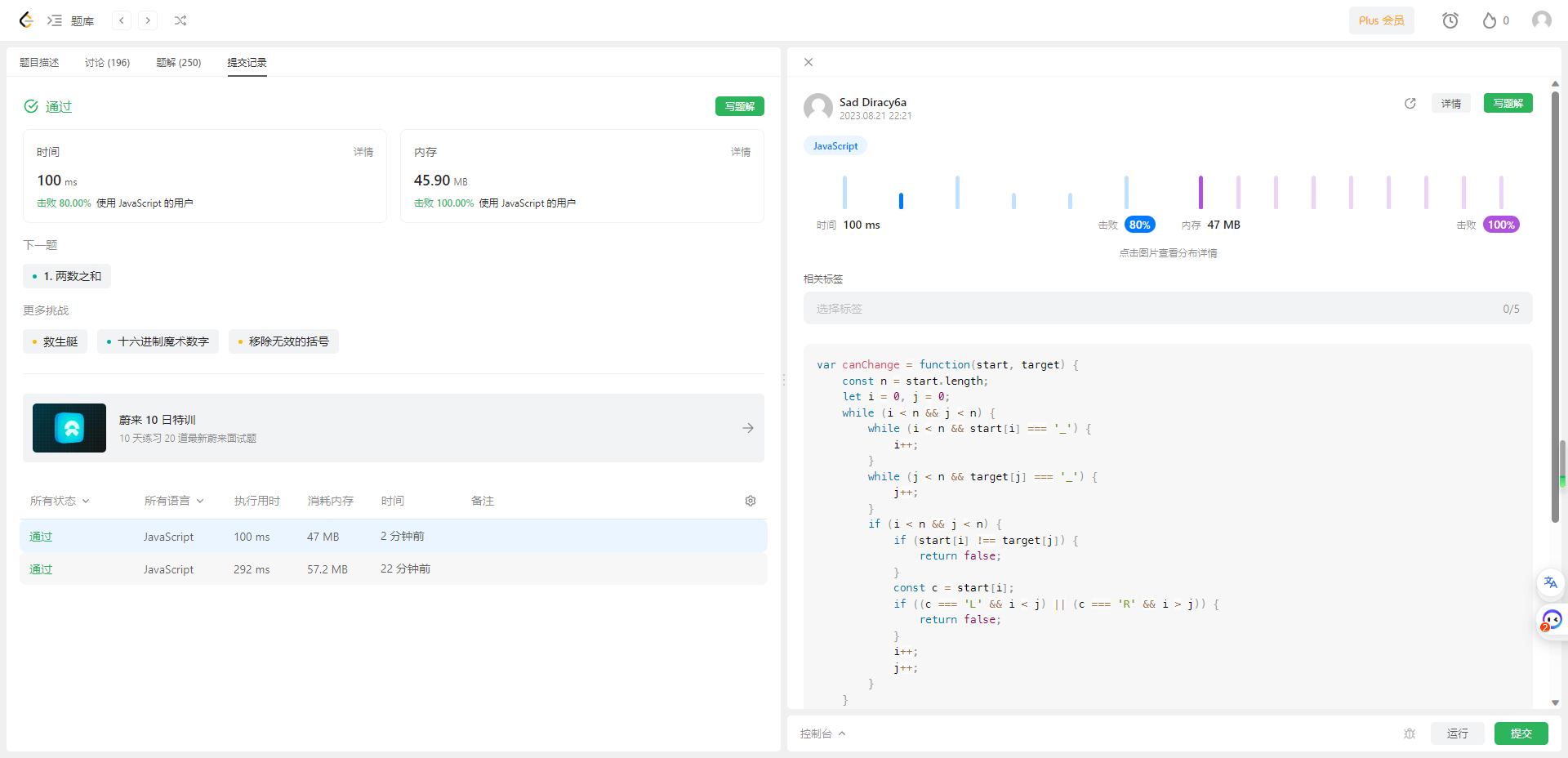leetcode每日一题(2023.8.21)
2337. 移动片段得到字符串
问题
给你两个字符串 start 和 target ,长度均为 n 。每个字符串 仅 由字符 'L'、'R' 和 '_' 组成,其中:
字符
'L'和'R'表示片段,其中片段'L'只有在其左侧直接存在一个 空位 时才能向 左 移动,而片段'R'只有在其右侧直接存在一个 空位 时才能向 右 移动。字符
'_'表示可以被 任意'L'或'R'片段占据的空位。
如果在移动字符串 start 中的片段任意次之后可以得到字符串 target ,返回 true ;否则,返回 false 。
示例 1:
输入:start = "_L__R__R_", target = "L______RR"
输出:true
解释:可以从字符串 start 获得 target ,需要进行下面的移动:
- 将第一个片段向左移动一步,字符串现在变为 "L___R__R_" 。
- 将最后一个片段向右移动一步,字符串现在变为 "L___R___R" 。
- 将第二个片段向右移动三步,字符串现在变为 "L______RR" 。
可以从字符串 start 得到 target ,所以返回 true 。
示例 2:
输入:start = "R_L_", target = "__LR"
输出:false
解释:字符串 start 中的 'R' 片段可以向右移动一步得到 "_RL_" 。
但是,在这一步之后,不存在可以移动的片段,所以无法从字符串 start 得到 target 。
示例 3:
输入:start = "_R", target = "R_"
输出:false
解释:字符串 start 中的片段只能向右移动,所以无法从字符串 start 得到 target 。
提示:
n == start.length == target.length1 <= n <= 105start和target由字符'L'、'R'和'_'组成
答案
var canChange = function(start, target) {
// Check if the number of 'L' and 'R' are the same in start and target
if (start.replace(/_/g, '').split('').sort().join('') !== target.replace(/_/g, '').split('').sort().join('')) {
return false;
}
// Check if the sequence of 'L' and 'R' in start can be transformed to the sequence in target
let i = 0, j = 0;
while (i < start.length && j < target.length) {
while (i < start.length && start[i] === '_') i++;
while (j < target.length && target[j] === '_') j++;
if (i === start.length && j === target.length) return true;
if (i === start.length || j === target.length) return false;
if (start[i] !== target[j]) return false;
if (start[i] === 'L' && i < j) return false;
if (start[i] === 'R' && i > j) return false;
i++;
j++;
}
while (i < start.length && start[i] === '_') i++;
while (j < target.length && target[j] === '_') j++;
return i === start.length && j === target.length;
};
结果

分析
这个函数的主要逻辑是通过比较start和target中的’L’和’R’字符的位置和数量来判断start是否可以通过移动字符转换为target。下面是对每段代码的详细解释:
JavaScript
var canChange = function(start, target) {这一行定义了一个名为canChange的函数,该函数接受两个参数:start和target。
if (start.replace(/_/g, '').split('').sort().join('') !== target.replace(/_/g, '').split('').sort().join('')) {
return false;
}这段代码首先移除start和target字符串中的所有空位字符(‘_’),然后将剩余的字符排序并组合成新的字符串。如果排序后的字符串不相同,那么函数返回false,表示start不能转换为target。
let i = 0, j = 0;
while (i < start.length && j < target.length) {
while (i < start.length && start[i] === '_') i++;
while (j < target.length && target[j] === '_') j++;
这段代码定义了两个指针i和j,分别用于遍历start和target字符串。在每次循环开始时,指针会跳过所有的空位字符。
if (i === start.length && j === target.length) return true;
if (i === start.length || j === target.length) return false;
这段代码检查是否已经遍历完所有的非空位字符。如果两个字符串的所有非空位字符都已经被遍历,那么函数返回true。如果只有一个字符串的非空位字符被遍历完,那么函数返回false。
if (start[i] !== target[j]) return false;
if (start[i] === 'L' && i < j) return false;
if (start[i] === 'R' && i > j) return false;
这段代码比较start和target中当前位置的字符。如果字符不同,或者字符的移动方向不对(例如’L’向右移动或’R’向左移动),则返回false。
i++;
j++;
这段代码将两个指针向前移动一位,以便在下一次循环中比较下一个字符。
while (i < start.length && start[i] === '_') i++;
while (j < target.length && target[j] === '_') j++;
return i === start.length && j === target.length;
这段代码在遍历完所有非空位字符后,跳过剩余的空位字符。如果所有的字符都被正确地处理了,那么函数返回true。
官方解答
var canChange = function(start, target) {
const n = start.length;
let i = 0, j = 0;
while (i < n && j < n) {
while (i < n && start[i] === '_') {
i++;
}
while (j < n && target[j] === '_') {
j++;
}
if (i < n && j < n) {
if (start[i] !== target[j]) {
return false;
}
const c = start[i];
if ((c === 'L' && i < j) || (c === 'R' && i > j)) {
return false;
}
i++;
j++;
}
}
while (i < n) {
if (start[i] !== '_') {
return false;
}
i++;
}
while (j < n) {
if (target[j] !== '_') {
return false;
}
j++;
}
return true;
};
作者:力扣官方题解
链接:https://leetcode.cn/problems/move-pieces-to-obtain-a-string/solutions/1855012/yi-dong-pian-duan-de-dao-zi-fu-chuan-by-0j7py/
来源:力扣(LeetCode)
著作权归作者所有。商业转载请联系作者获得授权,非商业转载请注明出处。
官方答案分析
这个函数的主要逻辑是通过比较start和target中的’L’和’R’字符的位置和数量来判断start是否可以通过移动字符转换为target。下面是对每段代码的详细解释:
var canChange = function(start, target) {
这一行定义了一个名为canChange的函数,该函数接受两个参数:start和target。
const n = start.length;
let i = 0, j = 0;
这两行代码初始化了三个变量:n是字符串的长度,i和j是用于遍历字符串的指针。
while (i < n && j < n) {
while (i < n && start[i] === '_') {
i++;
}
while (j < n && target[j] === '_') {
j++;
}
这段代码使用两个内部循环跳过start和target中的空位字符(‘_’)。
if (i < n && j < n) {
if (start[i] !== target[j]) {
return false;
}
这段代码比较start和target中当前位置的字符。如果字符不同,那么函数返回false。
const c = start[i];
if ((c === 'L' && i < j) || (c === 'R' && i > j)) {
return false;
}
这段代码检查字符的移动方向。如果’L’字符在start中的位置小于在target中的位置,或者’R’字符在start中的位置大于在target中的位置,那么函数返回false。
i++;
j++;
这段代码将两个指针向前移动一位,以便在下一次循环中比较下一个字符。
while (i < n) {
if (start[i] !== '_') {
return false;
}
i++;
}
while (j < n) {
if (target[j] !== '_') {
return false;
}
j++;
}
这段代码在遍历完所有非空位字符后,检查start和target中是否还有剩余的非空位字符。如果有,那么函数返回false。
return true;
如果所有的字符都被正确地处理了,那么函数返回true。
反思
官方使用了两个指针i和j来同时遍历start和target字符串,并且在遍历过程中跳过了所有的空位字符。这样代码只需要遍历一次字符串,而不是像我之前的解决方案那样需要遍历两次。此外,官方代码在处理完所有非空位字符后,会额外检查start和target中是否还有剩余的非空位字符。这个额外的检查可以提前结束函数的执行,从而提高性能,代码更加精简和高效
